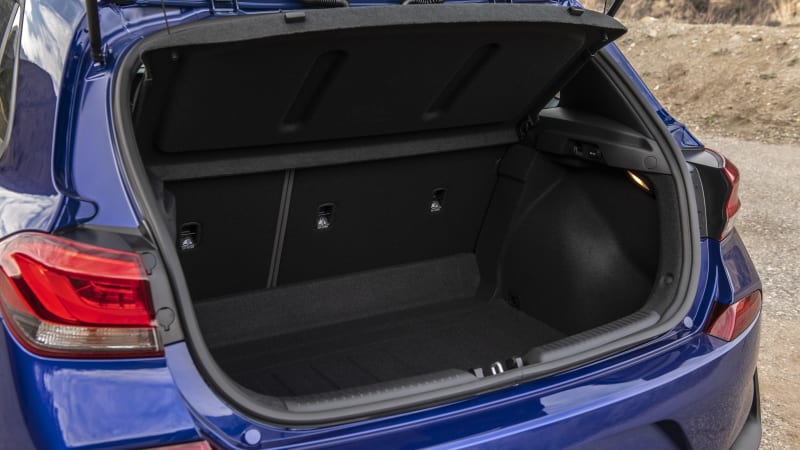2020 Hyundai Elantra Review & Buying Guide | Tale of Two Compacts
https://ift.tt/31MDFtv
The 2020 Hyundai Elantra is a sensible, small sedan that scores big when it comes to overall value and safety. However, the Elantra won’t get any pulses racing when it comes to driving excitement, or a look-at-me exterior. Rivals like the Honda Civic and Mazda 3 are simply more fun and refined to drive, so if you’re looking for something beyond just strong value and safety, those will probably be more attractive choices.
That said, versions of the Elantra are more engaging and interesting than others. That includes the Elantra GT, a handy – and handsome – four-door hatchback. Sold as the i30 in Europe, and featuring different exterior and interior styling as a result, it’s a more practical alternative to the Elantra sedan that’s a bit sharper to drive. It’s also available as the more powerful N Line, which along with the Elantra Sport sedan, gets a more powerful engine and an upgraded suspension. Those considering higher-performance variants of rivals like the Honda Civic Si and VW GTI should check them out.
What’s new for 2020?
The current-generation Elantra debuted for 2017, but there were significant design changes last year. For 2020, Hyundai focused on the powertrain. All Elantra sedans with a naturally aspirated engine now use a CVT. Unless you’re piloting an Elantra GT, it’s all CVT and dual-clutch automatic units — the standard GT has a traditional six-speed automatic. Hyundai also eliminated the manual transmission from the sedan lineup – even the turbocharged Sport model is dual-clutch only now.
More options became standard features for 2020, as well. Every Elantra gets dual-zone automatic climate control, lane-keeping assist and automatic emergency braking. Those new features are not standard on the Elantra GT (pictured below).
What’s the interior and in-car technology like?
Interestingly, the Elantra sedan and Elantra GT hatchback feature different interior designs (seen below). The main difference is infotainment screen placement, which also forces a change in air vent integration. There’s some differentiation in the button and knob positions in the two center stacks, too. Ultimately, both are perfectly attractive, and feature splashes of silver trim that break up a general monotone environment of average black plastic. Red accents at least spruce up the Sport and N Line cars. It’s subdued and classy until we get to the red air vent surrounds on the N Line — the Sport doesn’t feature red on the vents, and the styling looks a hair bit better for it. Functionally, with both designs, the gauges and dials are easy to see and use. There are useful storage cubbies throughout, the best being the hollowed-out area forward of the gear lever. Items like a phone fit nicely, and they won’t fly out.
The touchscreen infotainment systems may be placed differently in each body style, but the actual unit itself is the same. Easy to use and reach, the 7-inch touchscreen on SEL models and above works like a charm (the base model gets a perfectly serviceable 5-inch touchscreen). Apple CarPlay and Android Auto come as standard so long as the 7-inch screen is in the car. If you opt for the Limited, more luxuries like wireless phone charging, heated seats, auto high-beam assist and leather seats are along for the ride. That makes the higher trims a slightly more desirable place to be, but the entry-level Elantras are still plenty acceptable. Interior features and appearance is where Hyundai can generally get a step up on the competition. We like what has been done here, but it certainly doesn’t wow like the Mazda3, and the quality isn’t quite to the level of a Civic or upper trim levels of the Toyota Corolla.
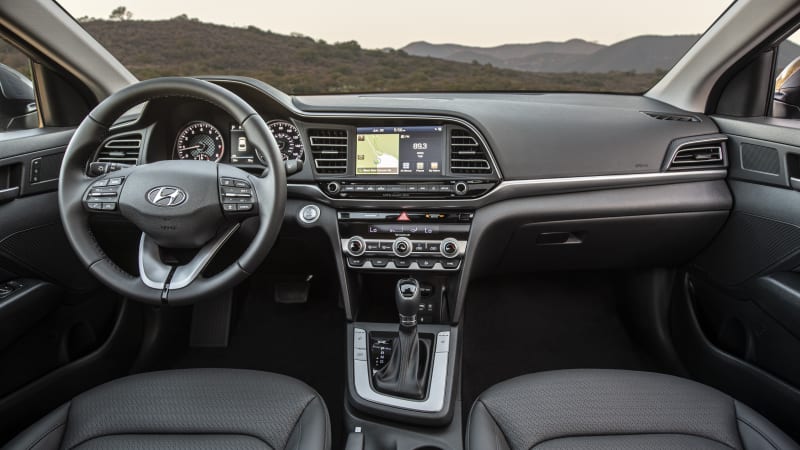
 Elantra sedan left, Elantra GT N Line right
Elantra sedan left, Elantra GT N Line right
How big is it?
The 2020 Hyundai Elantra is considered a compact car, sized to compete with other compacts like the Honda Civic and Toyota Corolla. At 181.9 inches in length for the sedan, it’s just about spot on compared to those in its competitive set. Like many hatchback variants, the Elantra GT is considerably shorter at 170.9 inches. That reduction in length doesn’t hurt it as much as one may expect when it comes to utility.
The sedan provides 35.7 inches of rear legroom, while the GT has 34.8 inches. Having sat in both, we don’t think that difference is significant. Neither are the sedan’s 11 inches of extra length when you consider cargo space. The GT offers a cavernous 24.9 cu-ft behind its rear seats compared to the 14.4 cu-ft in the trunk of the sedan. True, those numbers mask a difference in shape (the GT’s area is taller, the sedan’s deeper), but when you lower the hatchback’s seats, the greater versatility on hand is undeniable with a total of 55.4 cu-ft of open space. That’s comparable to some small SUVs and if practicality is a priority, the GT is the easy choice among the two body styles.
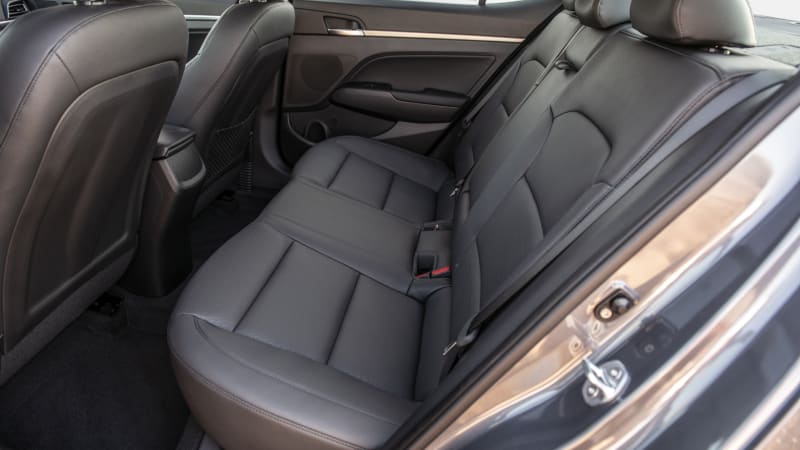

What are the performance and fuel economy?
The entry-level SE, SEL, Value Edition, and Limited trim level all come standard with a 2.0-liter four-cylinder that delivers 147 horsepower and 132 pound-feet of torque. It’s paired exclusively with a continuously variable transmission. The SE is rated for 35 mpg combined, whereas the rest of the trims earn a 34 mpg combined rating.
A turbocharged 1.4-liter four-cylinder that generates 128 hp and 156 lb-ft of torque is standard on the fuel-miser Eco trim level. It comes coupled to a seven-speed dual-clutch automatic and nets 36 mpg combined.
The Elantra GT comes standard with a 2.0-liter inline-four that produces 161 hp and 150 lb-ft of torque. It comes exclusively with a six-speed automatic and returns 27 mpg combined.
Meanwhile, the Elantra Sport and Elantra GT N Line come fitted with a more powerful turbocharged 1.6-liter four-cylinder that delivers a total of 201 hp and 195 lb-ft of torque. With the Sport, it’s paired to a dual-clutch auto and achieves 29 mpg combined. With the GT N Line, it comes with the dual-clutch auto or six-speed manual — the manual gets 26 mpg combined and the automatic brings that up to 28 mpg combined.

What’s it like to drive?
As expected, the Elantra’s driving experience is heavily predicated on which trim you choose. A regular sedan with the CVT is slow, favoring maximum fuel economy over driver enjoyment. Its chassis is fine, but doesn’t encourage spirited driving. Ride quality is about on-par with others in this segment — it’s no luxury car, but it won’t rattle your teeth out either. The power is plenty for most, but competitors have even stronger engines when in base spec. Our experience with the mechanically related Kia Forte indicates the CVT should be acceptable when found in the Hyundai, but check back on this review for more impressions once we get some seat time with the new transmission.
Go for an Elantra Sport, and the 1.6-liter turbo spices things up considerably. Hyundai even changes the rear suspension design from a torsion beam to a fully-independent design for better handling. The dual-clutch automatic is solid, but don’t expect lightning quick shifts. It gets points for being better than the retired six-speed automatic in the regular Elantra, but we still yearn for a manual.
You’ll need to find yourself an Elantra GT N Line to get that third pedal, but it’s totally worth it. The sporty model replaces the GT Sport and leans even further into the enthusiast realm of small, fun cars. It’s about 8/10ths of a Civic Si in the fun-to-drive department, and a limited-slip differential away from being an incredibly difficult choice between the two. Hyundai stiffened the chassis considerably for this model and added aggressive Michelin Pilot Sport 4 summer tires. The little hatchback grips like crazy and is a riot to throw around on a good road. Hyundai hasn’t given it the lovely manual transmission of the Veloster N, but the six-speed still has decent feel through gear changes and an easy to modulate clutch. We highly recommend checking this model out if you’re in the market for an engaging yet cheap hatchback.
What more can I read about the Hyundai Elantra?
Read about the substantial design update that occurred last year.
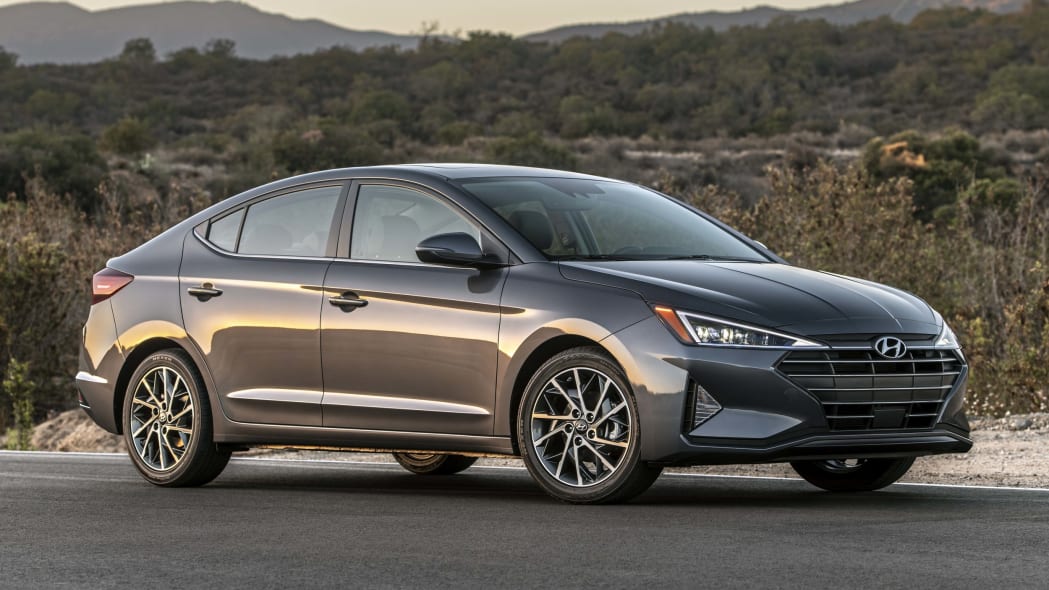
We drive the Elantra GT Sport, which was the precursor to the Elantra GT N Line. The N Line leans even more in the hot hatch direction.
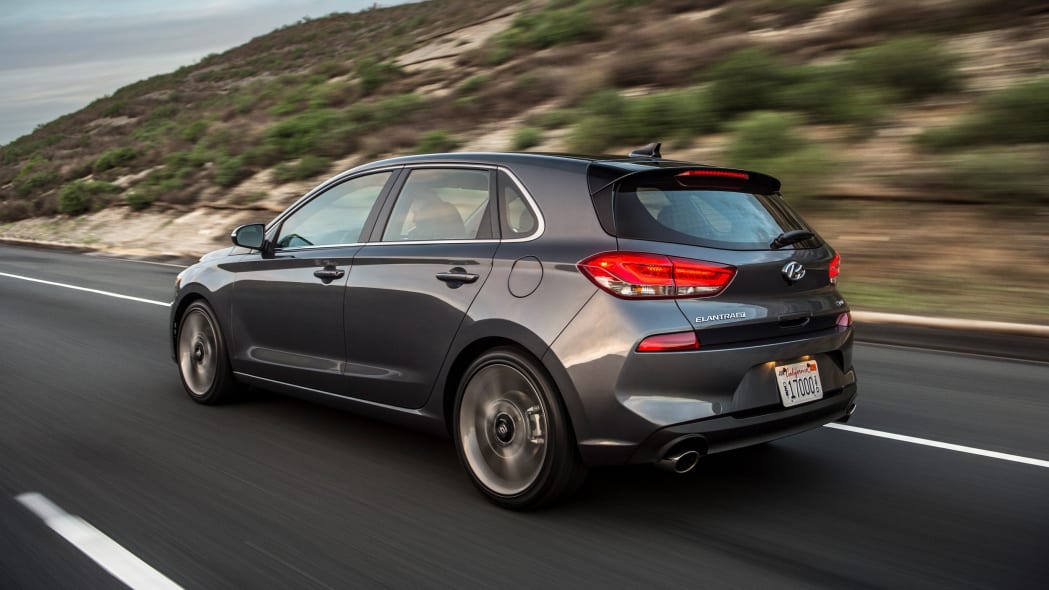
The current-generation Elantra dates back to 2017. Despite its updated styling, or impressions remain broadly the same.
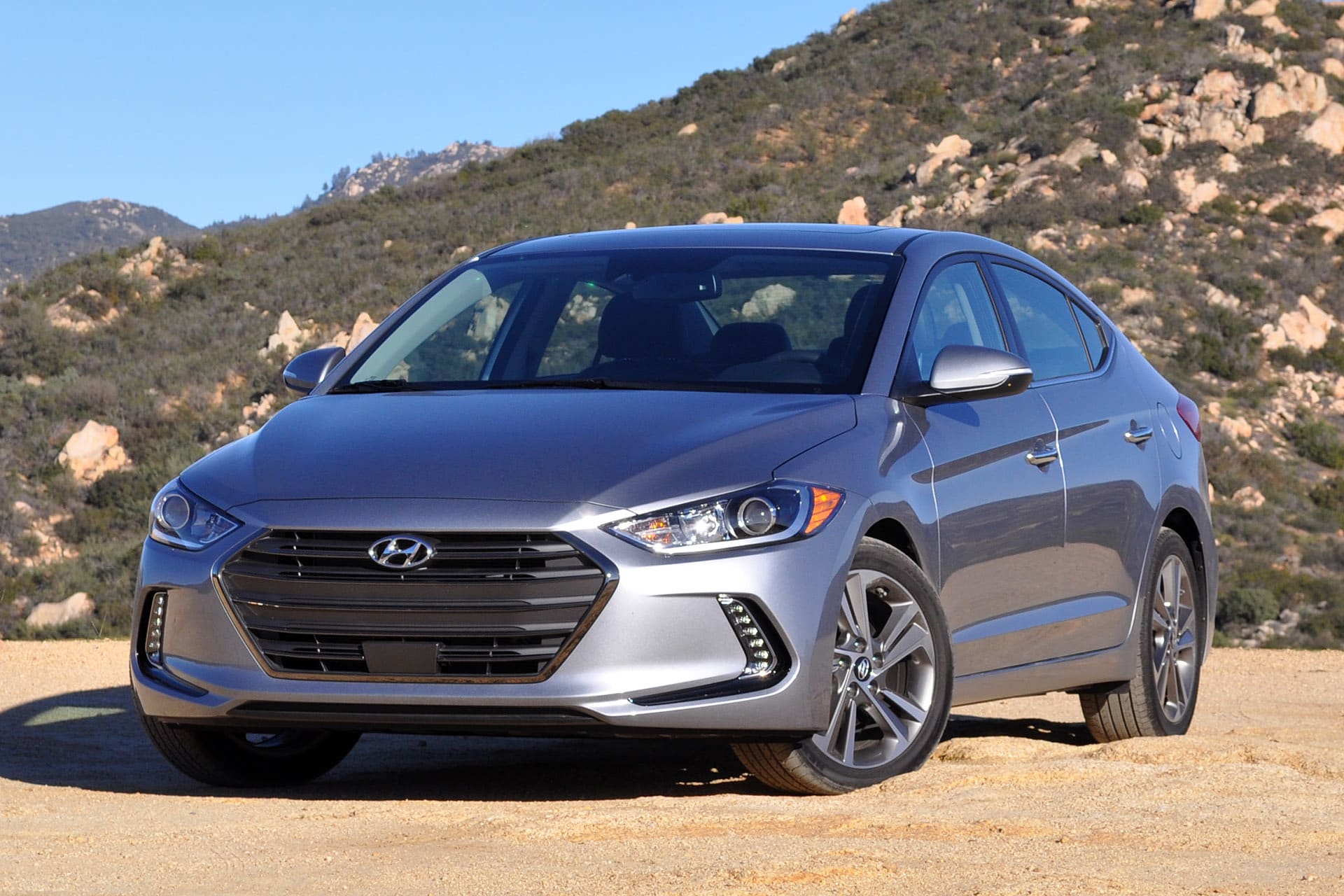
We get our first crack at the driver-focused Elantra Sport. The manual is no longer available.
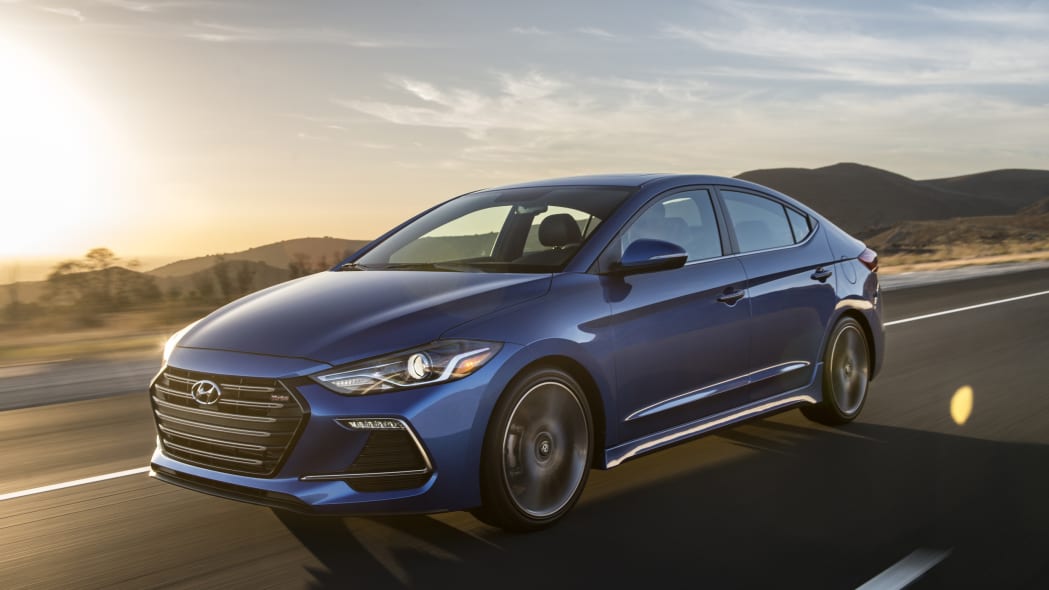
What features are available, and what’s the price?
The 2020 Hyundai Elantra SE starts at $19,880, including the $930 destination charge. A top-of-the-line Limited begins at $23,730, but to get every last luxury you’ll need the Ultimate package, bringing a fully-loaded Elantra up to $27,080. A Sport can be had for $24,730.
The base SE comes with a decent roster of standard features, the most notable mentioned in the “What’s new” section above. Besides those, you get 15-inch steel wheels, halogen headlights, cloth seats, a USB outlet, and a 5-inch touchscreen. Apple CarPlay and Android Auto show up with the 7-inch touchscreen (among many other upgrades) in the SEL trim.
The base price of each trim is listed below, but we provide a full breakdown of features, specs and local pricing here on Autoblog:
Sedan
- SE: $19,880
- SEL: $20,630
- Value Edition: $21,530
- Eco: $22,180
- Limited: $23,730
- Sport: $24,730
Hatchback
- GT: $21,380
- GT N Line: $24,230
What are Elantra’s safety equipment and crash ratings?
A good deal of safety equipment is either standard or optional on the Elantra. Automatic emergency braking, lane-keep assist and a driver attention warning come on every trim. Available on higher trim levels is blind-spot warning, rear cross-traffic warning, adaptive cruise control, auto high-beam assist and Hyundai’s “Safe Exit Assist” that keeps a rear seat passenger from opening a rear door if an oncoming vehicle is detected.
The Hyundai Elantra sedan and hatchback received a four-star overall crash rating from the government, which isn’t atypical for the segment, but it demonstrated an elevated risk of injury for rear seat passengers in a side impact. Its side rating is still four stars, however. The Elantra received high marks from the Insurance Institute for Highway Safety, earning a Top Safety Pick+ rating. The Elantra GT only managed a Top Safety Pick rating without the +, on account of its poorer performing headlights.
Auto Blog
via Autoblog https://ift.tt/1afPJWx
October 24, 2019 at 10:13AM

